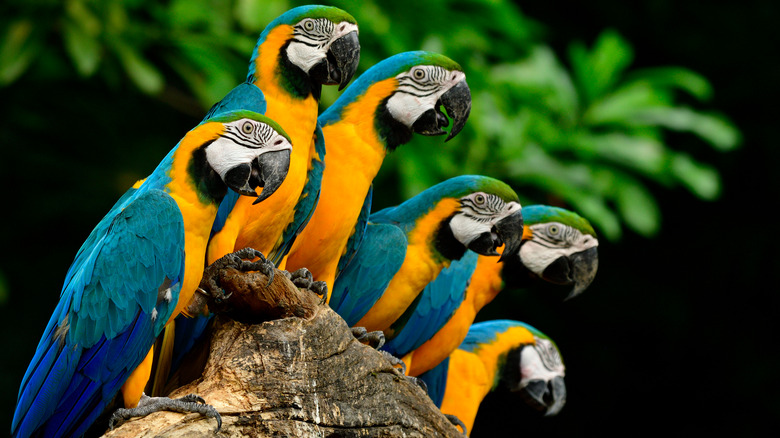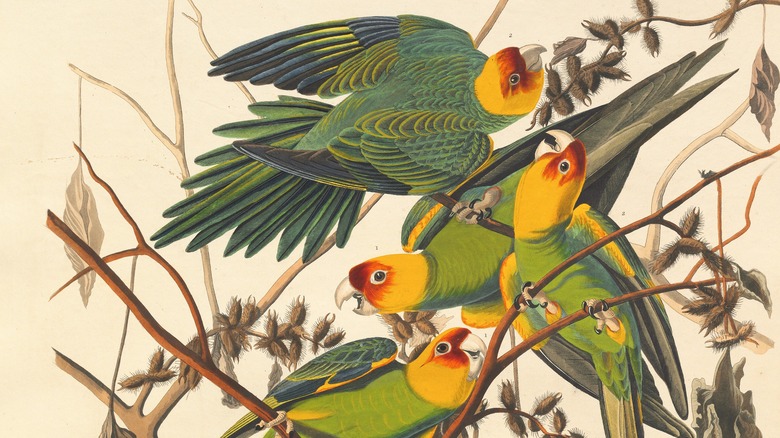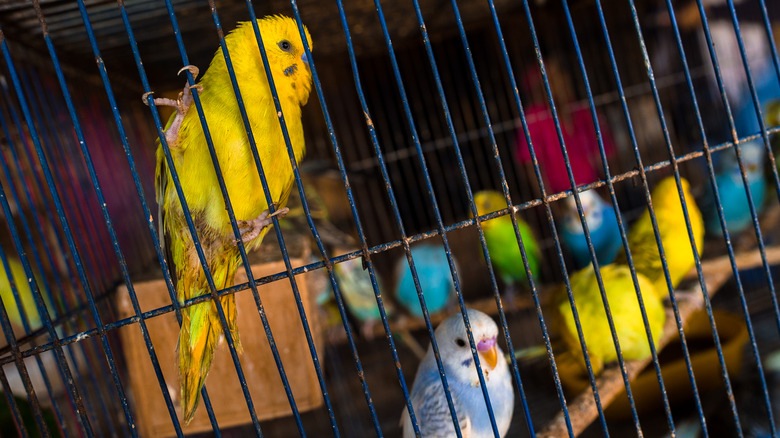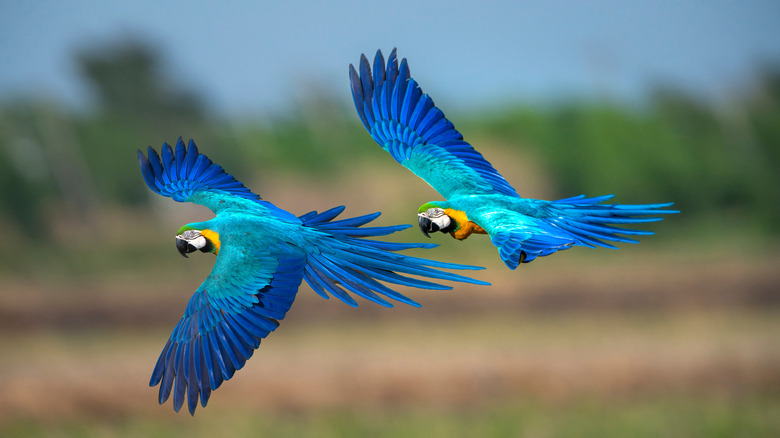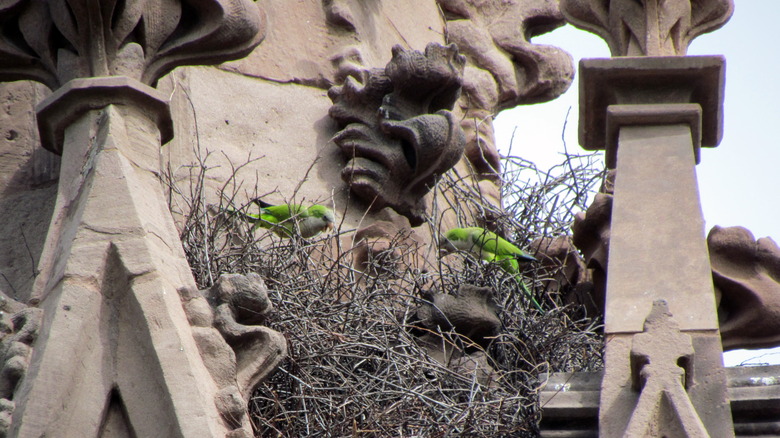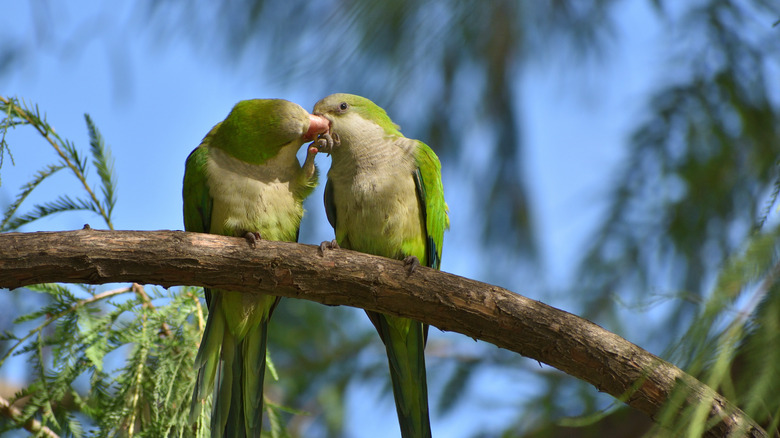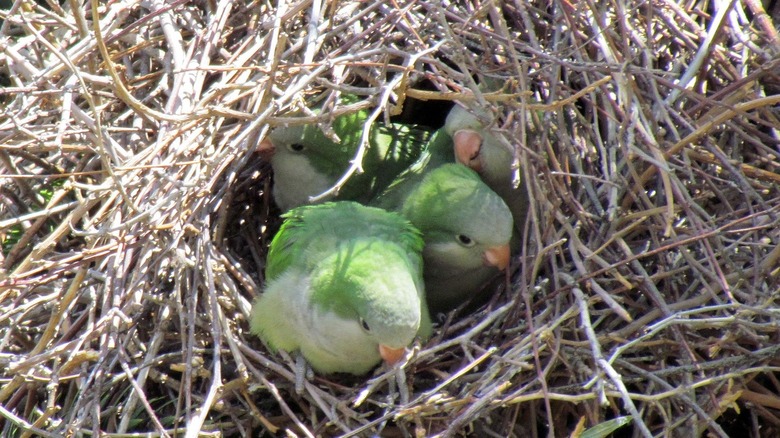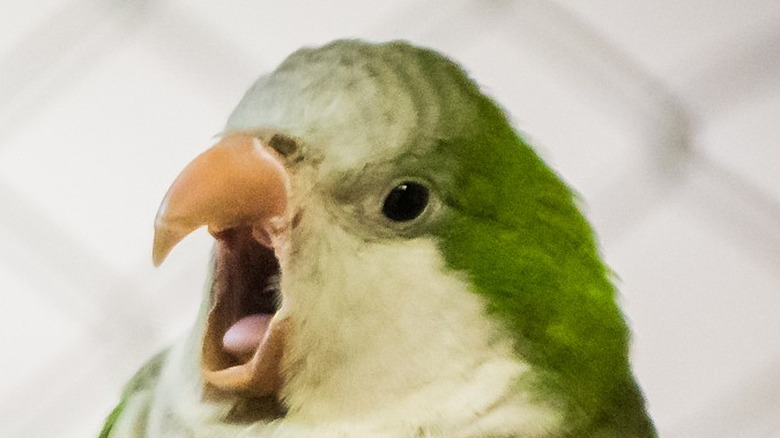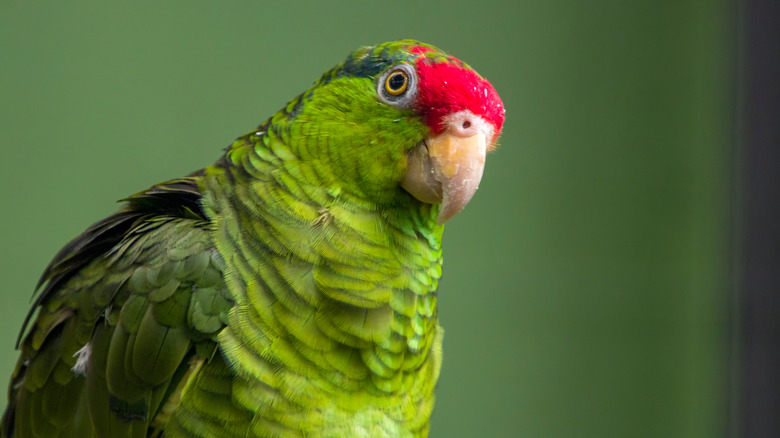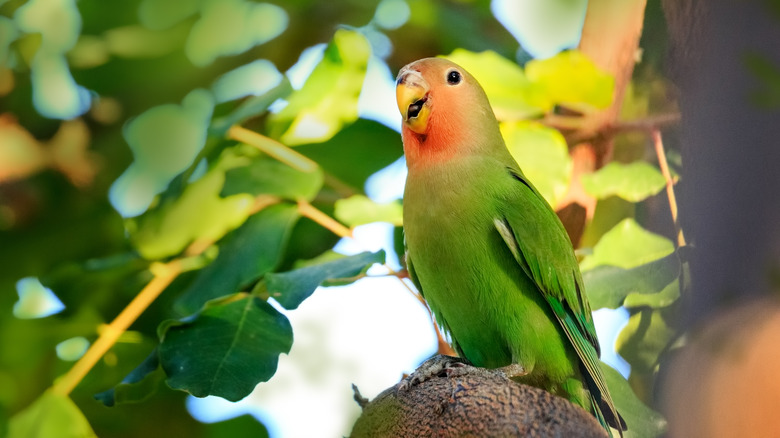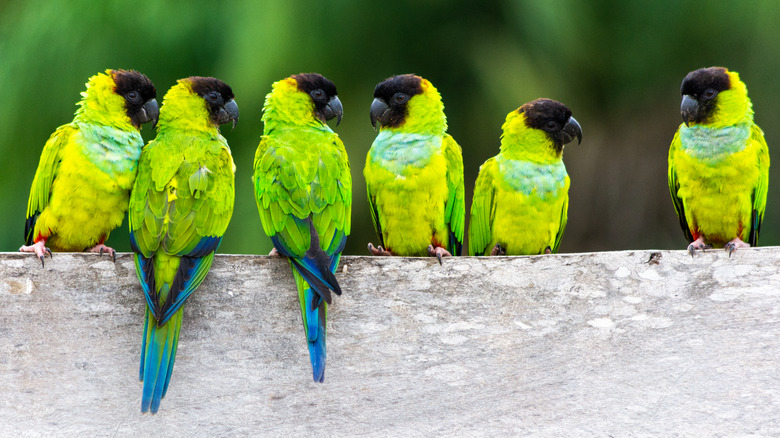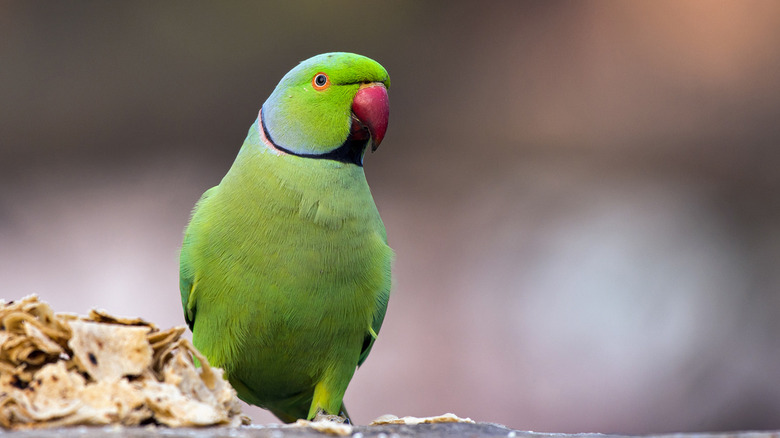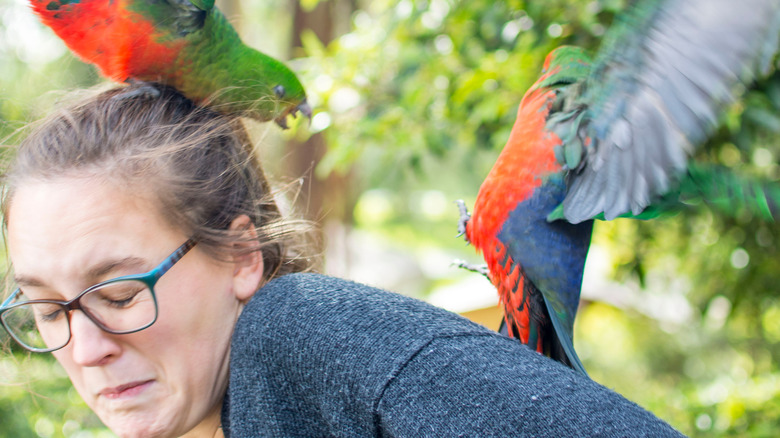America's Strange Feral Parrot Colonies Explained
An oasis in urban New York is the 478-acre Green-Wood Cemetery in Brooklyn. The cemetery was still considered a rural area when it was established in 1838, but today it is surrounded by the brimming populations of Park Slope, Windsor Terrace, Borough Park, and Sunset Park. Aside from the famous historical persons interred there, such as Boss Tweed and Horace Greeley, it also offers a rare opportunity for urbanites to experience nature. The New York City branch of the Audubon Society proclaims it a prime urban spot with chances to snatch a view of warblers in spring, Baltimore orioles in summer, thrushes in fall, owls in winter, and parrots year round. Yes, parrots.
These are the same birds of the family Psittacidae, which Britannica points out are warm-weather birds. In fact, most are tropical. How can there be wild parrots in northerly Brooklyn? How did they even get there in the first place? To the delight of some and the dismay of others, these gaudily feathered birds are storming the nation. Intelligent, raucous, and colorful, parrots have such charisma that unlike most other invasive species — think longhorn beetles or zebra mussels or murder hornets — they are viewed by many as charming and welcome additions. So let's take a look and see how these tropical invaders got a featherhold in the United States and in many people's hearts.
America had two native parrots
Most people do not realize that the United States had its own native parrot species. If you took a time machine back about a century and a half ago, you would have found two parrot species living in the country. The first, as described by Audubon, is the Carolina parakeet, which one could encounter as far north as Wisconsin and as far south as the Gulf of Mexico. This green bird with a yellow head was driven to extinction by habitat loss and active human predation. (They were seen as vermin, and also their feathers were fashionable for hats.) It did not help that the birds tended to flock back to same spot after a number of their comrades had been shot down, setting the stage for repeat massacres. The last known captive Carolina parakeet died in 1918 at the Cincinnati Zoo, ironically in the same enclosure where the last passenger pigeon died.
The other native parrot is the thick-billed parrot, which the National Park Service tells us inhabited the Southwest, where they would fly as flocks into canyons and forage for pine seeds. It was extirpated in the United States by 1938. Attempts were made to reintroduce the parrot in the late 20th century, but the effort was a failure. Fortunately, the species still survives in Mexico.
What these two species didn't have, apparently, was the tenacious panache of the parrots that were in the exotic pet trade.
Feral parrot colonies are caused by the exotic pet trade
Be it a gorgeous macaw or a savvy African grey, parrots are popular pets. This popularity has contributed to their endangerment, since illegal trapping in the wild, compounded by habitat loss, has forced many species to the brink. For example, National Geographic describes how Australian palm cockatoos can sell for $30,000 on the black market. Only four of about 350 parrot species are not threatened. In America today, most parrots you encounter in a pet store are captive-bred. Unfortunately, this is not as true in many other countries.
The trouble is that people take on parrots because they have great traits such as intelligence, beauty, and personality — but parrots can become overwhelming. The birds are loud, can be destructive, and can live eight decades. As a result, many are given up for adoption, and some are abandoned.
This is how America's strange parrot colonies got started. According to Audubon, in the mid-20th century, parrots started to become very popular pets. By the 1970s, thousands of wild-born ones had been imported into the United States. Some of them escaped, while others were just released by owners who could not cope with their new pets. These became the seed population for parrot colonies. A paper published in the Journal of Ornithology tells us that 56 species of wild parrots have been seen in 43 states, and 25 of those species are breeding.
Most parrot colonies are in the warmer states
It should come as no surprise that parrots flourish best in warmer environments. According to Audubon, Florida, Texas, and California have the most parrot sightings. In fact, all 25 species of feral parrots have gotten a clawhold in these states. South Florida has proved to be particularly hospitable. Miami Living featured an article that details how budgerigars, canary-winged parakeets, rose-ringed parakeets, and at least 17 other species are in and about Miami. Since South Florida is subtropical, some may wonder if some of these naturalized birds had flown in on their recognizance. The truth is that parrots are non-migratory, so these are all wild-born pets and their offspring. Incidentally, none of these naturalized populations show any sign of the mimicry that has made parrots famous.
While Florida is a haven for many parrot species — Audubon tells us that people build special nesting boxes to attract them — they have also extensively colonized more northerly climes. This just shows the adaptability and tenacity of these birds.
Humans are parrot enablers
For at least two millennia, parrots have been kept as pets. However, a paper published in the science journal Diversity titled "The Number and Distribution of Introduced and Naturalized Parrots" tells us that these populations have only been established within the last few decades. So why haven't parrots established colonies way before the 20th century?
The answer seems to be that humans have become better enablers for parrots. Audubon explains that people have replaced native vegetation with exotic, tropical varieties. In warmer states, homeowners plant non-native fruit and flower trees, provide parrots with ample nourishment. Species such as the blue-and-yellow macaw, found in Florida, will chow down on any edible flower, fruit, or shoot it can sink its beak into. The birds then make homes for themselves in non-native palm trees or eucalyptus or sometimes in a big opening of a native oak. Thus, in virtually all cases, parrots can only live in the United States because we not only brought the birds, but also the food and domiciles that help them thrive.
One important point about these parrots is brought up by a blog post on Nature: Most of these parrot populations are found in urban areas. This may very well be because urban areas are so changed from their native state, making them more hospitable to non-native parrots.
The Monk Parakeet is America's most abundant parrot
The most common American feral parrot is the monk parakeet, sometimes called the Quaker Parrot. Originally from South America, Audubon relates how this small green bird became the first known parrot colonist in America. In fact, there is an urban legend that a shipment of the birds busted out of a crate at JFK airport to establish the New York population.
When these monk parakeet colonies were first being established in the late 1960s and early '70s, there were fears that the parrots would breed and infest the country, taunting humans with their squawks and head-bobbing and decimating our farms. Indeed, the parrot was more adaptable to colder northern climes since it builds its homes out of sticks and twigs rather than living in the cavities of trees. This allows the parrots to huddle together in large numbers for warmth through even the coldest winter. Their reputation for ransacking grain in their native South America was so great that an eradication campaign was launched in the 1970s by the U.S. Fish and Wildlife Service. This did not work. (No one seems to know why.) Nor have there been any particular means found to control them. The U.S. Department of Agriculture notes, "Various audio, chemical, and visual deterrents have been tested at substations to deter parakeet nesting, but none has proved effective."
New York parrots cause power problems
Those parrots that have colonized the most northern states in America are invariably monk parakeets. Discover Magazine tells us that these birds have made it big time in the Big Apple, living opportunistically on whatever they have been able to find, such as pizza crusts. Monk parakeets have established colonies in all of the five of New York City's boroughs and can be found in the Hudson Valley. Typically, they make nests wedged in power towers, atop stadium lights, or around junction boxes. The birds are attracted to these sites partly because the electricity helps to warm the nests in the winter. These nests can grow quite large, weighing up to a ton and housing 200 pairs of parakeets.
As you might imagine, building huge twig nests into live electrical lines can lead to disaster. Nests sometimes catch fire, and as the parrots' homes incinerate, they take out the power network. As a result, nest removal is an ongoing activity during the spring, when growing nests are removed before the breeding season so there are no eggs. While other invasive species are seen as threats, in the Big Apple, at least, monk parakeets have found a happy equilibrium, as many residents seem to like these green-feathered immigrants.
Monk parakeets are banned in several states
Monk parakeets are popular in some quarters and their advocates want them to thrive, even extolling them as an excellent replacement for the extinct Carolina parakeet. But, alas, some governmental authorities have gone in the opposite direction. California's relationship with the monk parakeet is detailed in "Naturalized Parrots of the World." In that state, monk parakeets are about as welcome as bubonic plague. You cannot sell, transport, trade, or own one. Petkeen, which compiles information on monk parakeet bans, notes that the primary justification for the ban is that the birds are considered agricultural pests. This ban is not just a West Coast phenomenon. Prohibitions on monk parakeets have been enacted in a range of severity in Connecticut, Pennsylvania, Kentucky, Georgia, Hawaii, Rhode Island, Maine, Colorado, and Wyoming.
But like so many other issues in America, monk parakeets are divisive. Florida, for example, has an opposite approach — not only can you own one, but you can breed them and, if you'd like, release them into the wild. This patchwork network of regulations ultimately does not serve the country well if the goal is to control the species.
Red-crowned Amazon parrots are California dreaming
In some cases, these feral populations of parrots have actually managed to help improve a species' chances of long-term survival. One of the best examples of this is the red-crowned Amazon. The California Parrot Project tells us that this species comes from Mexico but has established substantial colonies in urban and suburban areas in California, especially around Los Angeles. There, according to LAist, flocks let loose their brazen calls at sunrise and sunset to the delight (or annoyance) or resident humans.
These colonies are refugees from their native land, where they are endangered. In Mexico, there are an estimated 3,000 to 10,000 individuals, while Los Angeles county hosts 3,000. The book "Why Parrots?" notes that some scientists think there may now be more feral red-crowned Amazons in California and in Texas (its other colony site) than in Mexico. This has led supporters of these parrot colonies to contend that they can act as reservoirs as species get squeezed out of their original habitats.
Phoenix has become a haven for rosy-faced lovebirds
One curious parrot colony is thriving in Phoenix, Arizona. According to Arizona Field Ornithologists, beautifully colored rosy-faced lovebirds, which are popular pet parrots, have made a home for themselves in city parks and residential backyards, where they nest in ornamental palm trees or the native cacti of the region. Bird census takers have estimated that they number at about 2,500 individuals. This is the only population of wild rosy-faced lovebirds in the United States.
Here, thousands of miles away from its native range in southwestern Africa, the lovebirds have found almost the equivalent of the dry, woody climate of their native home. They are able to thrive in the greatly modified humanscape of exotic plants furnished through irrigation. Audubon tells us that even though Phoenix can see extremes of heat, these parrots adapt and flock to air conditioning vents to remain cool. While the population in Phoenix appears to be thriving, it seems that the city is just an island of lovebirds — they have yet to establish colonies outside the city. This indicates that they are wholly reliant on humans for their survival.
The Nanday Parakeet is the third most common American parrot
Another parrot immigrant which has made a new life in America is the nanday parakeet, also known as the black-hooded parakeet for its darkly colored head. This species, as explained by Audubon, originates in Brazil to Argentina in central South America, and is known for its high-pitched calls. "Why Parrots?" informs us that this is the third most common wild parrot species in the United States. Populations are definitely established in California and Florida, while sightings have occurred in Texas and Arizona.
The nanday parakeet's experiences in Florida are illustrative of the confusion over feral parrot populations. Wild South Florida explains how it is thought that the first Nandays to live wild in Florida dated back to 1969, and that noticeable populations had appeared by the 1980s. Even at that point, it was thought that the colonies were mainly comprised of escapees and were not necessarily breeding populations. However, in 1992, Congress passed the Wild Bird Conservation Act, which resulted in a ban on their importation. Their continued presence shows that these colonies were not built up from imported escapees, but rather were independently breeding.
This is not just an American issue
"The Number and Distribution of Introduced and Naturalized Parrots" tells us that the United States is home to the largest population of feral parrots, but it is definitely not an American phenomenon. Phys.org reports that throughout Europe, the ring-necked parakeet and the monk parakeet have established substantial populations numbering in the tens of thousands. These are at the vanguard of a host of other beaked invaders who have established colonies on the continent. Here, as in the United States, there are fears that these parrot populations will wreak considerable damage on agriculture. One example is that ring-necked parakeets apparently did enough damage to crops at a vineyard in Surrey, U.K., to cause the loss of thousands of bottles of wine. In truth, however, there is limited evidence of extensive crop damage. More concerning is the impact of these newcomers on native species by taking over their nesting — or, in the case of an endangered bat species in Seville, Spain, their roosting sites. However, the overall impact of these parrot species does seem to be minimal at present.
Parrots: friend or foe?
Should these parrots be removed because they are invasive, or should they continue to exist because we like them? While the damage being done by feral parrots seems to be minimal at present, this is not to say that at some point in the future there won't be some other unintended, negative consequence. Gizmodo points out that there are many advocates for these charismatic birds who view them more as an enhancement to the ecosystem and possibly a reservoir for species in danger in their native habitats. As a result, there is a patchwork quilt of legislation regulating the birds, where some states, such as New York and New Jersey, toy with the idea of protecting them, while others, as we have seen, just ban them.
The Sierra Club weighed in on the debate and pointed out that parrots in America are only invasive because we humans have created an artificial ecosystem that allows them to survive. Stephen Pruett-Jones, an ornithologist with the University of Chicago, told the club's magazine, "We don't have any naturalized parrots living truly in the wild outside some association with humans. Their foraging is done in parklands or suburban habitats where we've planted ornamental fruit and flowering trees. We've modified our habitat to suit ourselves, and that's been absolutely perfect for the parrots."
So the bottom line is that these invasive parrots are as invasive as we humans.
